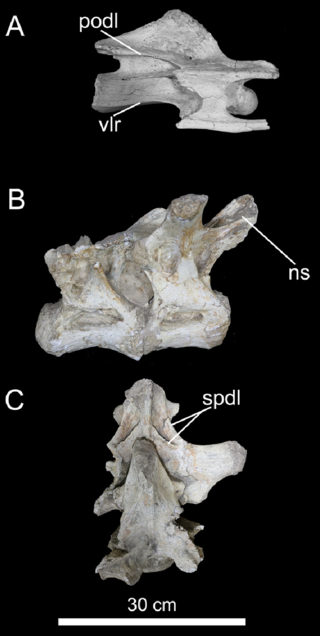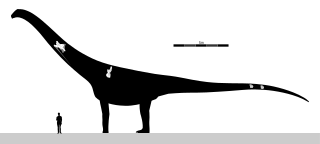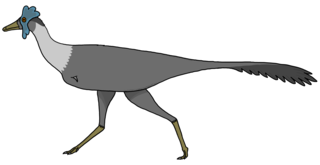
Titanosaurs were a diverse group of sauropod dinosaurs, including genera from all seven continents. The titanosaurs were the last surviving group of long-necked sauropods, with taxa still thriving at the time of the extinction event at the end of the Cretaceous. This group includes some of the largest land animals known to have ever existed, such as Patagotitan—estimated at 37 m (121 ft) long with a weight of 69 tonnes —and the comparably-sized Argentinosaurus and Puertasaurus from the same region.

Alamosaurus is a genus of opisthocoelicaudiine titanosaurian sauropod dinosaurs containing a single known species, Alamosaurus sanjuanensis, from the Maastrichtian age of the Late Cretaceous period in what is now southwestern North America. Isolated vertebrae and limb bones indicate that it reached sizes comparable to Argentinosaurus and Puertasaurus, which would make it the absolute largest dinosaur known from North America. Its fossils have been recovered from a variety of rock formations spanning the Maastrichtian age. Specimens of a juvenile Alamosaurus sanjuanensis have been recovered from only a few meters below the Cretaceous-Paleogene boundary in Texas, making it among the last surviving non-avian dinosaur species. Alamosaurus is the only known sauropod to have inhabited North America after their nearly 30-million year absence from the North American fossil record and probably represents an immigrant from South America.

Aeolosaurus is a genus of titanosaurian sauropod dinosaur from the Late Cretaceous Period of what is now South America. Like most sauropods, it would have been a quadrupedal herbivore with a long neck and tail. Aeolosaurus is well known for a titanosaur, as it is represented by the remains of several individuals belonging to at least two species. However, like most titanosaurs, no remains of the skull are known. The holotype of Aeolosaurus rionegrinus consists of a series of seven tail vertebrae, as well as parts of both forelimbs and the right hindlimb. It was discovered in the Angostura Colorada Formation in Argentina, which dates from the Campanian stage of the Late Cretaceous, about 83 to 74 million years ago. The species A. maximus was transferred over to the new genus Arrudatitan in 2021.

Andesaurus is a genus of basal titanosaurian sauropod dinosaur which existed during the middle of the Cretaceous Period in South America. Like most sauropods, belonging to one of the largest animals ever to walk the Earth, it would have had a small head on the end of a long neck and an equally long tail.
Venenosaurus is a genus of sauropod dinosaur that lived in what is now Utah during the Early Cretaceous. Its type and only species is Venenosaurus dicrocei. Fossils of Venenosaurus were first discovered in 1998, by Denver Museum of Natural History volunteer Anthony DiCroce, and described as a new genus and species in 2001 by Virginia Tidwell and colleagues, who named the species for DiCroce. Venenosaurus was a relatively small sauropod, and was similar to Cedarosaurus, another sauropod from the Early Cretaceous of Utah.

Isisaurus is a genus of titanosaurian dinosaur from the Late Cretaceous Lameta Formation of India and Pab Formation of Pakistan. The genus contains a single species, Isisaurus colberti.

Epachthosaurus was a genus of titanosaurian sauropod dinosaur from the Late Cretaceous. It was a basal lithostrotian titanosaur. Its fossils have been found in Central and Northern Patagonia in South America.

Neuquensaurus is a genus of saltasaurid sauropod dinosaur that lived in the Late Cretaceous, about 80 million years ago in Argentina in South America. Its fossils were recovered from outcrops of the Anacleto Formation around Cinco Saltos, near the Neuquén river from which its name is derived.

Trigonosaurus, is a genus of saltasaurid dinosaurs from the Maastrichtian Serra da Galga Formation of Brazil. The type species, Trigonosaurus pricei, was first described by Campos, Kellner, Bertini, and Santucci in 2005. It was based on two specimens, both consisting mainly of vertebrae. The two specimens were originally believed to have come from the same individual. However, one specimen was described as the holotype of Caieiria in 2022, while the holotype may have instead come from Baurutitan. Before its description, it was known as the "Peirópolis titanosaur", after the place it was found.

Lirainosaurus is a genus of titanosaur sauropod which lived in what is now Spain. The type species, Lirainosaurus astibiae, was described by Sanz, Powell, Le Loeuff, Martinez, and Pereda-Suberbiola in 1999. It was a relatively small sauropod, measuring 4 metres (13 ft) long, possibly up to 6 metres (20 ft) long for the largest individuals, and weighed about 2–4 metric tons.

Puertasaurus is a genus of sauropod dinosaur that lived in South America during the Late Cretaceous Period. It is known from a single specimen recovered from sedimentary rocks of the Cerro Fortaleza Formation in southwestern Patagonia, Argentina, which probably is Campanian or Maastrichtian in age. The only species is Puertasaurus reuili. Described by the paleontologist Fernando Novas and colleagues in 2005, it was named in honor of Pablo Puerta and Santiago Reuil, who discovered and prepared the specimen. It consists of four well-preserved vertebrae, including one cervical, one dorsal, and two caudal vertebrae. Puertasaurus is a member of Titanosauria, the dominant group of sauropods during the Cretaceous.

Lithostrotia is a clade of derived titanosaur sauropods that lived during the Early Cretaceous and Late Cretaceous. The group was defined by Upchurch et al. in 2004 as the most recent common ancestor of Malawisaurus and Saltasaurus and all the descendants of that ancestor. Lithostrotia is derived from the Ancient Greek lithostros, meaning "inlaid with stones", referring to the fact that many known lithostrotians are preserved with osteoderms. However, osteoderms are not a distinguishing feature of the group, as the two noted by Unchurch et al. include caudal vertebrae with strongly concave front faces (procoely), although the farthest vertebrae are not procoelous.
Malarguesaurus is a genus of titanosauriform sauropod dinosaur from the Late Cretaceous of Mendoza Province, Argentina. Its fossils, consisting of tail vertebrae, chevrons, ribs, and limb bones, were found in the upper Turonian-lower Coniacian Portezuelo Formation of the Neuquén Group. The type species, described by González Riga et al. in 2008, is M. florenciae.

Aeolosaurini is an extinct clade of titanosaurian dinosaurs known from the Cretaceous period of Argentina and Brazil. Rodrigo M. Santucci and Antonio C. de Arruda-Campos (2011) in their cladistic analysis found Aeolosaurus, Gondwanatitan, Maxakalisaurus, Panamericansaurus and Rinconsaurus to be aeolosaurids.

Saltasaurinae is a subfamily of titanosaurian sauropods known from the late Cretaceous period of South America, India and Madagascar.

Bonapartenykus is a monospecific genus of alvarezsauroid dinosaur from Argentina that lived during the Late Cretaceous (Campanian-Maastrichtian) in what is now the upper Allen Formation of the Río Negro Province. The type and only species, Bonapartenykus ultimus, is known from a nearly articulated but partial skeleton that was found in close association to two incomplete eggs and several clusters of eggshells belonging to the oogenus Arriagadoolithus. Bonapartenykus was named in 2012 by Federico L. Agnolin, Jaime E. Powell, Fernando E. Novas and Martin Kundrát. Bonapartenykus has an estimated length of 2.5 m (8.2 ft) and weight of 72 kg (159 lb), making it the largest member of the clade Alvarezsauroidea.

Eutitanosauria is a clade of titanosaurs, encompassing the more derived members of the group and characterized by the absence of the hyposphene-hypantrum articulation and possibly the presence of osteoderms. The group was first named by Sanz and colleagues in 1999, who used it to unite the group of Argyrosaurus, Lirainosaurus, Saltasaurus and the Peiropolis titanosaur. However, this definition was not used as it made the group equivalent to Saltasauridae, so Saldago redefined it in 2003 to be all titanosaurs closer to Saltasaurus than Epachthosaurus. This definition created Eutitanosauria as the sister group to Epachthosaurinae, but was problematic due to the variable nature of Epachthosaurus. Eutitanosauria was often broadly similar to Lithostrotia, and has often been unused or unlabelled on phylogenies. Sometimes Epachthosaurus would be more primitive than Malawisaurus, making Eutitanosauria more encompassing than Lithostrotia, or Epachthosaurus could nest close to Colossosauria and limit Eutitanosauria to a smaller group of saltasauroids. Because of the flexible nature of Epachthosaurus in basal titanosaur phylogeny, Carballido and colleagues redefined the group in 2022 to include the smallest clade of both Patagotitan, a colossosaur, and Saltasaurus, creating a node-stem clade with Colossosauria and Saltasauroidea, presenting the informal cladogram of stable titanosaur clades below.

Arrudatitan is an extinct genus of titanosaur sauropod dinosaur known from the Late Cretaceous (Campanian-Maastrichtian)-aged Adamantina Formation of Brazil. The type species, A. maximus, was named and described in 2011 as a species of Aeolosaurus, but was separated into its own genus in 2021. It was relatively gracile for a titanosaur.

Saltasauroidea is a superfamily of titanosaurs named by França and colleagues in 2016 based on their phylogenetic results, for a clade uniting Aeolosaurini and Saltasauridae, as well as the intermediate genera Baurutitan, Diamantinasaurus and Isisaurus. The group was not defined or discussed in the text, but was supported by Carballido and colleagues in 2022 as a useful designation for subdividing titanosaurs. As there was no discussion about the intentions for the clade, Carballido gave it the definition of all taxa closer to Saltasaurus than Patagotitan, encompassing half of Eutitanosauria as the sister taxon to the inversely defined Colossosauria. Carballido et al. placed Nemegtosauridae and Saltasauridae within the group, though they had Aeolosaurini within Colossosauria. The informal cladogram of titanosaur relationships they proposed is shown below.
Udelartitan is an extinct genus of saltasauroid titanosaurian sauropod dinosaur from the Late Cretaceous Guichón Formation of Uruguay. The genus contains a single species, U. celeste, known from fragmentary remains of at least two individuals.




























